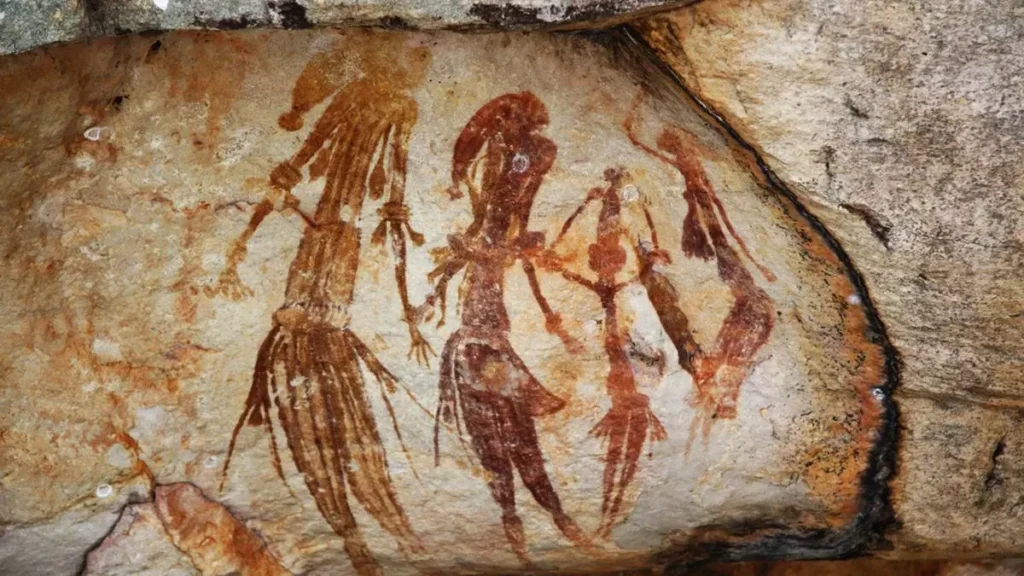The Palaeolithic Period, commonly referred to as the Old Stone Age, where the ancient art of crafting stone tools took shape and became a defining aspect of human prehistoric technology. Journey through time to explore the diverse phases and remarkable archaeological sites that reveal the story of our early ancestors.
Palaeolithic Period will be helpful for UPSC IAS Exam preparation. GS Paper-1 History and Art & Culture.
Table of Content
- Palaeolithic Period
- Parts of Palaeolithic Period
- Palaeolithic period in India
- Parts of Palaeolithic Period
- Lower Paleolithic Age
- Middle Paleolithic Age
- Upper Paleolithic Age
- Conclusion
- Frequently Asked Questions (FAQs)
Palaeolithic Period
- Palaeolithic period is also known as the Old Stone Age.
- The period is distinguished by the original development of stone tools, which represents almost the entire period of human prehistoric technology.
- The regular use of tools, beginning 2.6 m.y. ago in East Africa is well attested and accompanies many earlier and later hominid fossils.
- Indonesia: several hominid remains have recently been dated between 1.8 and 1.6 million years (m.y).
- China; the early stone tools are associated with human fossils dated between 1.7 and 1.9 m.y.
Palaeolithic period in India
- India has no human fossils have been found associated with Stone Age tools but it does have some idea of the antiquity of tools from the geological datings.
- The various strata of the Sivalik hills containing stone tools have been dated between 2 m.y. and 1,2 m.y.
- Another scientific date for the early stone tools came from the archaeological site of Bori in the Pune district of Maharashtra. Which is 1.38 m.y old.
Parts of Palaeolithic Period
- The Paleolithic Period is often divided into three parts:
- Lower Paleolithic: Handaxe and cleaver industries
- Middle Paleolithic: Tools made on flakes
- Upper Paleolithic: Tools made on flakes and blades
- The Paleolithic Age in India is divided into three phases by the type of stone tools used by the people and also according to the nature of climatic change.
- First phase may be placed broadly between 600,000 and 150,000 BC,
- Second between 150,000 and 35,000 BC, and
- Third between 35,000 and 10,000 BC.
Lower Paleolithic Age
- It is also known as the Early Old Stone Age covers the greater part of the ice age.
- The Early Old Stone Age may have begun in Africa around two million years ago, but in India, it is not older than 600,000 years.
- This date is given to Bori in Maharashtra.
- This site is considered to be the earliest Lower Paleolithic site.
Lower Paleolithic Tools:
- People use hand axes, cleavers, and choppers.
- The axes found in India are more or less similar to those of Westerns Asia, Europe, and Africa.
- Stone tools were used largely for chopping, digging, and skinning.
Lower Paleolithic Sites in India:
- Bori in Maharashtra is considered to be the earliest Lower Paleolithic site.
- Early Old Stone Age sites have been found in the valley of river Son or Sohan in Punjab, now in Pakistan.
- Several sites have been found in Kashmir and the Thar desert.
- Lower Paleolithic tools have also been found in the Belan Valley in UP and the desert area of Didwana in Rajasthan.
- Didwana yielded not only Lower Paleolithic stone tools but also those of the Middle and Upper Paleolithic ages.
- Chirki-Nevasa in Maharashtra has yielded as many as 2000 tools, and those have also been found at several places in the south.
Middle Paleolithic Age
- It is characterised basically by the flake tool industry.
- The middle Palaeolithic can be dated between 1,50,000 B.C. and 40,000B.C. or even slightly later.
Middle Palaeolithic tools:
- The tool types include small and medium-sized handaxes, cleavers and various kinds of scrapers, borers, and knives.
- Middle Palaeolithic tools have mostly been found in Central India, Deccan, Rajasthan, Maharashtra, Tamil Nadu, Karnataka and Orissa.
Middle Paleolithic sites in India:
- The most important sites of the Middle Palaeolithic period areBhimbetka, Nevasa, Pushkar, Rohiri hills of upper Sind, and Samnapur on Narmada.
Upper Paleolithic Age
- The upper Palaeolithic period lasted from about 45,000 to 10,000 B.C.
- The basic technological innovation of the Upper Palaeolithic period is the method of producing parallel-sided blades from a carefully prepared core.
Middle Palaeolithic tools:
- The upper Palaeolithic tools have been found in Rajasthan, parts of the Ganga and Belan valleys, Central and Western India, Gujarat, Andhra Pradesh and Karnataka.
- Main tools types: scrapers, points, awls, burins, borers, knives, etc.
- The blade tools are comparatively large, sometimes up to 8 cm.
- One of the most remarkable discoveries of the Upper Palaeolithic period is that of a rubble-built roughly circular platform of about 85 cm in diameter.
- A piece of natural stone is placed on rubble-made platforms and worshipped as the female principle or Sakti in the countryside, passing for one Mai (Mother Goddess) or another.
Conclusion
From the Lower Paleolithic’s robust hand axes to the Middle Paleolithic’s delicate flakes and the Upper Paleolithic’s innovative blade production, each phase unravels a distinct chapter in human evolution. The discovery of ancient sites across India offers glimpses into the lives and skills of our predecessors. These archaeological remnants not only provide a window into our past but also ignite our curiosity and deepen our understanding of the remarkable journey of humanity.
Ref: Source-1
FAQs (Frequently Asked Questions)
Which age is the period of transition between the Palaeolithic and Neolithic age?
The Mesolithic Age is the period of transition between the Palaeolithic and Neolithic age.
What is the definition of Palaeolithic period?
The Palaeolithic Period, which is commonly referred to as the Old Stone Age, denotes a prehistoric time characterized by the advancement and utilization of tools made from stone.



